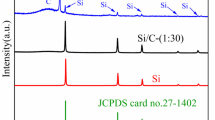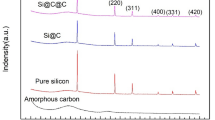Abstract
Nanosilicon materials are hardly used as anode materials of lithium batteries for the serious volume expansion during charging and discharging. Carbon-coated materials can reduce the volume effect of the silicon-improving cycle stability. In this paper, silicon/graphite (Si/G) composites were prepared by directly compounding silicon nanoparticles with graphite during size mixing, and (Si/G)@C composites were prepared by coating sucrose cracked carbon on the surface of silicon nanoparticles and graphite, and then spray drying the mixture and carbonized at 900 °С for 3 h under vacuum condition. The morphology and properties of the composites were compared by means of microstructure analysis and electrochemical performance tests. The results show that the improved electrochemical properties can be obtained by both composite methods. The Si/G composite delivers a high initial discharge capacity of approximately 597.9 mA h/g, with initial coulombic efficiency of 84.95%, and the reversible charge capacity is 423.5 mA h/g after 300 cycles with corresponding capacity retention ratio of 70.83%. The (Si/G)@C composite has better cycle life and coulombic efficiency with a discharge capacity of 572.9 mA h/g, and a capacity retention rate of 82.77% after 300 cycles. Coating carbon with silicon nanoparticles and graphite can improve the electrochemical properties of the (Si/G)@C composite electrode by preventing the crushing of active material particles, reducing the formation of SEI films, and enhancing the electrical conductivity of the particles.







Similar content being viewed by others
Data availability
The authors will supply the relevant data in response to reasonable requests.
References
G. Harper, R. Sommerville, E. Kendrick, L. Driscoll, P. Slater, R. Stolkin, A. Walton, P. Christensen, O. Heidrich, S. Lambert, A. Abbott, K.S. Ryder, L. Gaines, P. Anderson, Nature. (2019). https://doi.org/10.1038/s41586-019-1682-5
J.A. Sanguesa, V. Torres-Sanz, P. Garrido, F.J. Martinez, J.M. Marquez-Barja, Smart Cities. (2021). https://doi.org/10.3390/smartcities4010022
J. Nzabahimana, Z.F. Liu, S.T. Guo, L.B. Wang, X.L. Hu, ChemSusChem (2020). https://doi.org/10.1002/cssc.201903155
S. Chae, S.H. Choi, N. Kim, J. Sung, J. Cho, Angew. Chem. Int. Ed. (2020). https://doi.org/10.1002/anie.201902085
Z.T. Liu, J.T. Du, H.N. Jia, W.C. Wang, M.X. Zhang, J.K. Ma, Y. Nie, T.Q. Liu, K.D. Song, J. Mater. Sci. Mater. Electron. (2022). https://doi.org/10.1007/s10854-021-07500-2
L. Sun, Y.X. Liu, R. Shao, J. Wu, R.Y. Jiang, Z. Jin, Energy Storage Mater. (2022). https://doi.org/10.1016/j.ensm.2022.01.042
X.Z. Li, M. Zhang, S.X. Yuan, C.X. Lu, ChemElectroChem (2020). https://doi.org/10.1002/celc.202001060
W. Li, J.P. Yang, Z.X. Wu, J.X. Wang, B. Li, S.S. Feng, Y.H. Deng, F. Zhang, D.Y. Zhao, J. Am. Chem. Soc. (2012). https://doi.org/10.1021/ja3037146
H.W. Mi, X.D. Yang, Y.L. Li, P.X. Zhang, L.N. Sun, Chem. Eng. J. (2018). https://doi.org/10.1016/j.cej.2018.06.065
X.Q. Li, Y.F. Xing, J. Xu, Q.B. Deng, L.H. Shao, Chem. Commun. (2020). https://doi.org/10.1039/c9cc07997a
J.M. Su, C.C. Zhang, X. Chen, S.Y. Liu, T. Huang, A.S. Yu, J. Power Sources. (2018). https://doi.org/10.1016/j.jpowsour.2018.02.010
X. Han, Z.Q. Zhang, S.Y. Chen, Y. Yang, J. Power Sources. (2020). https://doi.org/10.1016/j.jpowsour.2020.228245
W.C. Wang, J.T. Du, Z.P. Xu, Z.T. Liu, H.A. Jia, T.J. Li, Y. Nie, K.D. Song, J. Mater. Sci. Mater. Electron. (2023). https://doi.org/10.1007/s10854-023-10215-1
Y.L. Chen, Y. Hu, Z. Shen, R.Z. Chen, X. He, X.W. Zhang, Y.Q. Li, K.S. Wu, J. Power Sources. (2017). https://doi.org/10.1016/j.jpowsour.2016.12.089
Q. Chen, Y. Nie, Y. Liu, J. Du, B. Ren, J. Mater. Sci. Mater. Electron. (2018). https://doi.org/10.1007/s10854-018-0517-8
Y. Man, R. Lin, J. Mater. Sci. Mater. Electron. (2020). https://doi.org/10.1007/s10854-020-04052-9
H.D. Chen, X.H. Hou, L.N. Qu, H.Q. Qin, Q. Ru, Y. Huang, S.J. Hu, K.H. Lam, J. Mater. Sci. Mater. Electron. (2017). https://doi.org/10.1007/s10854-016-5518-x
X.Q. Hu, S.M. Huang, X.H. Hou, H.D. Chen, H.Q. Qin, Q. Ru, B.L. Chu, Silicon (2018). https://doi.org/10.1007/s12633-017-9624-z
H.D. Chen, Z.L. Wang, X.H. Hou, L.J. Fu, S.F. Wang, X.Q. Hu, H.Q. Qin, Y.P. Wu, Q. Ru, X. Liu, S.J. Hu, Electrochim. Acta. (2017). https://doi.org/10.1016/j.electacta.2017.07.146
G.Q. Wang, B. Xu, J. Shi, X.L. Lei, C.Y. Ouyang, Appl. Surf. Sci. (2018). https://doi.org/10.1016/j.apsusc.2017.11.237
K.S. So, H. Lee, T.H. Kim, S. Choi, D.W. Park, Phys. Status Solidi. A (2014). https://doi.org/10.1002/pssa.201330059
W.P. Liu, H.R. Xu, H.Q. Qin, Y.L. Lv, G.S. Zhu, X.X. Lei, F. Lin, Z.J. Zhang, L.H. Wang, J. Mater. Sci. (2020). https://doi.org/10.1007/s10853-019-04313-x
M. Wang, X.R. Xiao, J. Power Sources (2016). https://doi.org/10.1016/j.jpowsour.2016.07.011
W.P. Liu, H.R. Xu, H.Q. Qin, Y.L. Lv, G.S. Zhu, F. Lin, X.X. Lei, Z.J. Zhang, L.H. Wang, Silicon (2020). https://doi.org/10.1007/s12633-019-00320-4
Y. Zhou, H.J. Guo, Z.X. Wang, X.H. Li, R. Zhou, W.J. Peng, J. Alloys Compd. (2017). https://doi.org/10.1016/j.jallcom.2017.07.279
W.P. Liu, H.R. Xu, X.X. Lei, Y.L. Lv, G.S. Zhu, H.Q. Qin, F. Lin, L.H. Wang, J. Electron. Mater. (2021). https://doi.org/10.1007/s11664-021-08754-6
N.T. Liu, J. Liu, D.Z. Jia, Y.D. Huang, J. Luo, X. Mamat, Y. Yu, Y.M. Dong, G.Z. Hu, Energy Storage Mater. (2019). https://doi.org/10.1016/j.ensm.2018.09.019
Y. Zhang, H. Chu, L. Zhao, L. Yuan, J. Mater. Sci. Mater. Electron. (2017). https://doi.org/10.1007/s10854-017-6357-0
Q. Man, Y. An, C. Liu, H. Shen, S. Xiong, J. Feng, J. Energy Chem. (2023). https://doi.org/10.1016/j.jechem.2022.09.020
W.P. Liu, H.R. Xu, H.Q. Qin, Y.L. Lv, F. Wang, G.S. Zhu, F. Lin, L.H. Wang, C.Y. Ni, J. Solid State Electrochem. (2019). https://doi.org/10.1007/s10008-019-04413-3
Y.L. Lv, F. Lin, W.P. Liu, X.X. Lei, H.Q. Qin, Z.J. Zhang, L.H. Wang, J. Mater. Sci. Mater. Electron. (2020). https://doi.org/10.1007/s10854-020-03672-5
H.L. Liu, W. Yang, S. Che, Y. Li, C. Xu, X. Wang, G. Ma, G.Y. Huang, Y.F. Li, Carbon (2022). https://doi.org/10.1016/j.carbon.2022.05.018
X. Liu, J. Lu, J. Jiang, Y. Jiang, Y. Gao, W. Li, B. Zhao, J. Zhang, Appl. Surf. Sci. (2021). https://doi.org/10.1016/j.apsusc.2020.148191
H.I. Park, Y.K. Park, S.K. Kim, H.D. Jang, H. Kim, ACS Appl. Mater. Interfaces. (2021). https://doi.org/10.1021/acsami.1c08969
C.L. Ma, Z.R. Wang, Y. Zhao, Y. Li, J. Shi, J. Alloys Compd. (2020). https://doi.org/10.1016/j.jallcom.2020.156201
M. Ratynski, B. Hamankiewicz, M. Krajewski, M. Boczar, A. Czerwinski, RSC Adv. (2018). https://doi.org/10.1039/c8ra02456a
G.M. Liang, X.Y. Qin, J.S. Zou, L.Y. Luo, Y.Z. Wang, M.Y. Wu, H. Zhu, G.H. Chen, F.Y. Kang, B.H. Li, Carbon (2018). https://doi.org/10.1016/j.carbon.2017.11.013
Y.C. Huang, H. Yang, T.Z. Xiong, D. Adekoya, W.T. Qiu, Z.M. Wang, S.Q. Zhang, M.S. Balogun, Energy Storage Mater. (2020). https://doi.org/10.1016/j.ensm.2019.11.001
G. Li, J.Y. Li, F.S. Yue, Q. Xu, T.T. Zuo, Y.X. Yin, Y.G. Guo, Nano Energy (2019). https://doi.org/10.1016/j.nanoen.2019.03.077
J. Bareno, I.A. Shkrob, J.A. Gilbert, M. Klett, D.P. Abraham, J. Phys. Chem. C (2017). https://doi.org/10.1021/acs.jpcc.7b06118
F. Zhang, X. Yang, Y.Q. Xie, N.B. Yi, Y. Huang, Y.S. Chen, Carbon (2015). https://doi.org/10.1016/j.carbon.2014.10.046
A.K. Roy, M.J. Zhong, M.G. Schwab, A. Binder, S.S. Venkataraman, Z. Tomovic, ACS Appl. Mater. Interfaces. (2016). https://doi.org/10.1021/acsami.5b12026
Y. He, K.X. Xiang, W. Zhou, Y.R. Zhu, X.H. Chen, H. Chen, Chem. Eng. J. (2018). https://doi.org/10.1016/j.cej.2018.07.165
T.S. Mu, P.J. Zuo, S.F. Lou, Q.R. Pan, Q. Li, C.Y. Du, Y.Z. Gao, X.Q. Cheng, Y.L. Ma, G.P. Yin, Chem. Eng. J. (2018). https://doi.org/10.1016/j.cej.2018.02.026
Z. Yi, N. Lin, T.J. Xu, Y.T. Qian, Chem. Eng. J. (2018). https://doi.org/10.1016/j.cej.2018.04.101
L. Shi, W.K. Wang, A.B. Wang, K.G. Yuan, Z.Q. Jin, Y.S. Yang, J. Mater. Chem. A (2015). https://doi.org/10.1039/c5ta03974f
Funding
This work was supported by Guangxi Science and Technology Project (Grant No. ZY21195037), the Scientific and Technological Plan of Guilin City (Grant No. 20210207-4), the Scientific and Technological Plan of Liuzhou City (Grant No. 2022CCC0201), Quzhou Science and Technology Bureau (Grant No. 2021K26), and the Joint Funds of the Zhejiang Provincial Natural Science Foundation of China (Grant Nos. LZY22E010002, LZY23E010001).
Author information
Authors and Affiliations
Contributions
CN: Conceptualization, Methodology, Investigation, Formal Analysis, Writing—Original Draft. CX: Conceptualization, Data curation, Writing—Review and Editing. WL: Conceptualization, Resources, Supervision. ZS:Resources, Supervision. XL:collated documents. HQ:Data curation. WX:participated in writing papers
Corresponding authors
Ethics declarations
Competing interest
The authors have no relevant financial or non-financial interests to disclose.
Additional information
Publisher’s Note
Springer Nature remains neutral with regard to jurisdictional claims in published maps and institutional affiliations.
Rights and permissions
Springer Nature or its licensor (e.g. a society or other partner) holds exclusive rights to this article under a publishing agreement with the author(s) or other rightsholder(s); author self-archiving of the accepted manuscript version of this article is solely governed by the terms of such publishing agreement and applicable law.
About this article
Cite this article
Ni, C., Xia, C., Liu, W. et al. Effect of combination methods for nanosilicon and graphite composites on the anode performance of lithium batteries. J Mater Sci: Mater Electron 34, 1432 (2023). https://doi.org/10.1007/s10854-023-10830-y
Received:
Accepted:
Published:
DOI: https://doi.org/10.1007/s10854-023-10830-y




